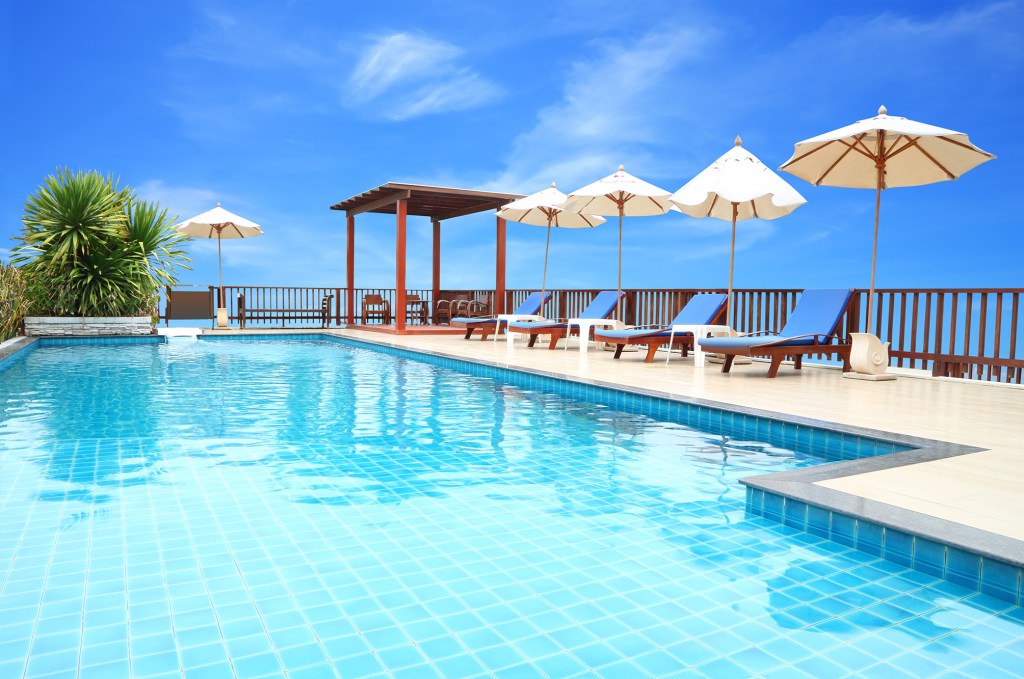When it comes to pool sanitation, there are a lot of options. But, in this situation, it’s entire possible to have too much of a good thing.
Two common options for pool sanitation are calcium hypochlorite (known as cal hypo) or with trichloroisocyanuric acid (known as trichlor). Both products add chlorine to the swimming pool, killing germs and sanitizing the water for swimming. However, both also introduce extra and different chemicals as well, some of which have their drawbacks when it comes to safety and performance.
Pool operators who choose them have their reasons; cost is often a large factor. However, though some chemicals may seem more cost-effective up front, maintaining the sanitizer will also add up in hidden costs.
Calcium hypochlorite increases pH, alkalinity and calcium hardness levels. Calcium hardness is important in water in that it protects surfaces, including plaster and metal, from corroding. Trichlor, on the other hand, reduces pH and alkalinity, but increases cyanuric acid (CYA). CYA helps protect chlorine from being decomposed in UV light. It is not recommended, however, for use indoors.
Both chemicals, however, have their capacity limits. Too much calcium from cal hypo can turn the water cloudy and cause scaling to occur. And too much CYA from trichlor can render the chlorine less effective in the water, making its sanitizing process much slower.
“Because CYA slows the disinfection rate of chlorine, there is a greater risk of illness from waterborne pathogens such as E. coli, giardia and cryptosporidium,” says Ellen Meyer, product safety and government affairs manager for Sigura. She points to research that showed that the risk of illness increases with increasing CYA concentration. “With just 20 ppm CYA, the risk of illness from crypto is over 10 times higher and the risk of giardia infection is 29 times higher compared to just 2 pm free chlorine alone without stabilization.”
When both chemical byproducts reach those limits, the only way to reduce them is by removing water – usually by backwashing the filter or physically removing water from the pool. Evaporation, however, is not an effective way to remove either calcium hardness or CYA, because they do not evaporate. This is where the unexpected costs begin – and is particularly difficult in drought-ridden areas, where emptying and refilling a pool is not an option.
Differences between cal hypo and trichlor
The real difference between the two chlorinators comes down to water levels and additional chemicals needed to maintain their byproducts in the correct levels.
Sanitizing with trichlor requires almost six times the amount of water to retain the CYA within range than it does to keep calcium hardness in check with cal hypo. Similarly, to maintain pH levels, other chemicals are needed. One option for neutralizing increased pH caused by cal hypo is with muriatic acid, and sodium carbonate to neutralize decreased pH caused by trichlor. However, it requires far less muriatic acid—almost 10 times less—to neutralize a pound of cal hypo compared to sodium carbonate for a pound of trichlor. Though at a glance, sodium carbonate and trichlor are both far less expensive than cal hypo and muriatic acid, the amount of sodium carbonate and trichlor required to maintain the pool pH greatly exceeds that of cal hypo and muriatic acid.
“If a stabilized chlorine product such as trichlor is used, then CYA levels will climb as you add more chlorine,” Meyer says. “For every ppm of available chlorine that is added to the pool, trichlor will contribute 0.6 ppm of CYA. It’s easy to see that if your commercial pool is feeding 10 ppm chlorine every day, that CYA levels can climb very quickly.”
Pool codes
Unfortunately, pool codes vary from state to state when it comes to guidance on these chemicals. Some may not have a pool code at all. Smaller (county and city) jurisdictions sometimes set their own code.
The variation from state to state can go as low as 0.25ppm in required minimum free chlorine residual (Colorado) and as high as 2 ppm minimum (several states). When it comes to maximum levels, the lowest is at 2.5 ppm (Kentucky) and the highest at 10 ppm in multiple other states. Some states do not allow CYA and set the maximum at 0ppm, while some states still permit as high as 150 ppm CYA. About half the states permit up to 90 or 100 ppm CYA.
Meyer recommends that operators use unstabilized chlorine and add CYA as needed to maintain a small residual that is just enough to provide the stabilization needed to maintain a chlorine residual. “Using this approach, you can stay in control of your CYA levels without having to drain the pool to reduce CYA concentrations,” she says.
The Centers for Disease Control and Prevention created and updates the Model Aquatic Health Code (MAHC) which provides a consistent, science-based standard for pools and spas that many jurisdictions use as a basis for maintaining their facilities. Sigura has worked closely to help write the MAHC and has participated on other industry committees to write water quality standards even before the MAHC existed. Many local jurisdictions have begun to follow the MAHC.
“We want our industry’s codes and standards to reflect the best science available and to provide practical guidance that protests public health and that is economically feasible so that facilities can remain open and provide people with the many health benefits they can get from swimming,” Meyer says.
For more information on cal hypo, visit cchpoolcare.com.
